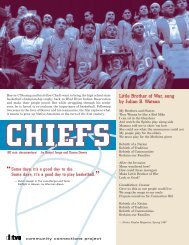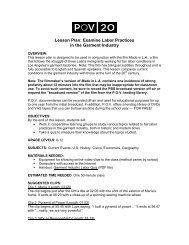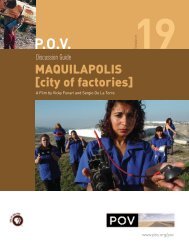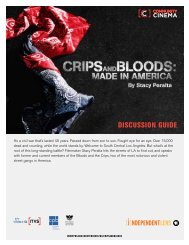Download Lesson Plan (PDF) - FutureStates
Download Lesson Plan (PDF) - FutureStates
Download Lesson Plan (PDF) - FutureStates
- No tags were found...
You also want an ePaper? Increase the reach of your titles
YUMPU automatically turns print PDFs into web optimized ePapers that Google loves.
COMMUNITY CLASSROOM: SEEDOverview of SeedIn an industry dominated by genetically modified seeds, a poor farmer struggles to survive. When he resortsto smuggling now-illegal organic seeds across borders, he risks everything.Summary of <strong>Lesson</strong>The lesson reviews the history of agricultural biotechnology. Students will propose a new GMO productbased on need, potential for profit, and minimal environmental effects. After the film is shown, studentswill be asked to consider a future similar to the one depicted in the film. Students are invited to make aprediction concerning the future use of GMOs. They will then investigate the predictions on the Predict-O-Meter, which is located on the FUTURESTATES website. Students are encouraged to add a prediction oftheir own design. Students will conclude the lesson by responding to a writing prompt.Background BriefThis is information for the teacher. It includes information about agricultural biotechnology that may help youguide your students as they contemplate the future status of GMOs.DefinitionsBefore investigating the development of genetically modified foods, it is important to understand thedifferences between conventional, organic, and genetically modified foods. Throughout history, conventionalfarming and organic farming have been virtually the same. It wasn’t until the development and subsequentwide-spread use of inorganic pesticides and herbicides during the mid-twentieth century that agriculturemoved away from organic farming techniques. Conventional farming differs from organic farming in its use ofsynthetic chemicals to enhance either the product itself or the productiveness of the product. Conventionalfarming utilizes herbicides, pesticides, fertilizers, and selected hormones to improve plant production. Routineuse of antibiotics and growth hormones is also employed in the raising of animals for human consumption.Organic farming generally prohibits the use of any inorganic pesticides, insecticides, or herbicides in theproduction of the food. Organically raised food is virtually free of antibiotics, growth hormones, and residualinorganic pesticides or herbicides. By definition, the genome is also free of any contaminants. This definitionprecludes the possibility of organic GMOs: although GMOs can be grown organically, the USDA does notcertify them as organic foods. Genetically modified foods may be raised either conventionally or organically.The distinction is in their genome. GMOs contain bits of other organisms’ DNA and are often termed“transgenic.”Selective BreedingHumans have been engaged in selective “engineering” for thousands of years. The selective crossing ofone individual with another to produce a desired trait in an offspring has been the basis for the developmentof the many breeds of domesticated plants and animals. In the past, the success or failure of an individualcross was largely a matter of chance, as explained by Mendel and other geneticists. Today, selectivebreeding occurs at the molecular level with the direct transfer of desired DNA from one organism to another.Bioengineering produces organisms with modified genomes. As a result, they are most often referred to asGMOs (genetically modified organisms).FUTURESTATES.TV PAGE 2

















